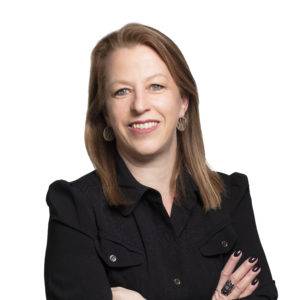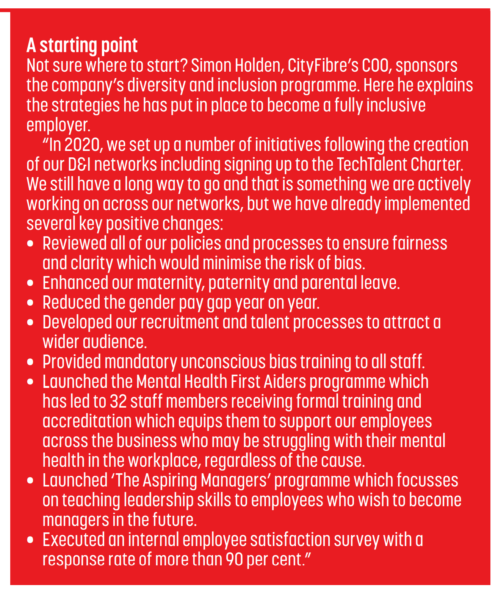
Businesses across the world have woken up to the reality that a diverse workforce is conducive to improved outcomes, from cultivating new ideas through to unlocking new customer bases. More importantly, any leader should know that providing equal opportunities regardless of who you are – whether that’s your age, gender, ethnicity, education, religion, disability, or whatever else might set you apart – is the ethical way to conduct business.
The channel is embracing these values. Numerous vendors, distributors and partners are placing diversity and inclusion at the forefront of their recruitment and workforce strategies. Yet understanding where things stand is not clear-cut. Detailed data is not readily available, initiatives deliver mixed results and businesses have different priorities.
Alex Tempest, managing director at BT Wholesale and Venture, has been an advocate for promoting diversity in the channel throughout her career. In previous roles as director of partners at TalkTalk, and director of systems integrators EMEA at Juniper, she worked particularly hard to get women involved in technology. She added, “Now, my goal is to tackle all stereotypes and help ensure BT Wholesale is a diverse, fair workplace for everyone regardless of gender, race, socio-economic background, disabilities and more.”
Progress has been made in recent years, but Tempest pointed out the areas that still need to be address. She explained, “Last year was without doubt a turbulent year and served to put a lot into perspective. One major example which gripped the world was the Black Lives Matter movement. Following events in the US, it has inspired change – not just in the channel but across society. It forced sectors to look within and assess how to improve inclusion. What’s more, enforced working from home has proven incredibly successful, demonstrating that organisations should consider remote options for workers, which in turn gives them access to the best talent in the world, regardless of geography or circumstance. We’re seeing new initiatives, pledges and ways of working come into effect.
“That said, I do feel our industry remains somewhat behind the curve in terms of diversity. There is still some way to go and channel partners can find it difficult to attract talent with diverse backgrounds and experiences. Real change needs to come from within; it is happening, but it’s gradual, not radical.”
 Louisa Gregory (pictured right), vice president for culture, change and diversity at Colt Technology Services agreed 2020 has compelled many organisations to act on diversity. She said, “The global pandemic has taught us many lessons and the impacts will continue to be studied and analysed for many years to come. But one of the spotlights that shone brightly in 2020 was the importance of inclusion and particularly equality. While I&D [inclusion and diversity] strategies and programmes are not new for many organisations, they have gained significant prominence with more work being done to support areas such as mental health, family needs or neurodiversity needs.”
Louisa Gregory (pictured right), vice president for culture, change and diversity at Colt Technology Services agreed 2020 has compelled many organisations to act on diversity. She said, “The global pandemic has taught us many lessons and the impacts will continue to be studied and analysed for many years to come. But one of the spotlights that shone brightly in 2020 was the importance of inclusion and particularly equality. While I&D [inclusion and diversity] strategies and programmes are not new for many organisations, they have gained significant prominence with more work being done to support areas such as mental health, family needs or neurodiversity needs.”
In terms of what can be done to deliver on these goals, Gregory explained that organisations need to examine their own culture and workforce to find the right approach for their business. “In our experience, there won’t be single initiatives that move the needle on I&D significantly or lead to ringing the diversity bell quickly. It can be tempting to jump straight to some of the big initiatives that try to make everyone feel celebrated and cherished, but without the right foundations in place, these are likely to be less impactful.”
Crissi Williams, CEO of the ITP, explained what is at stake should businesses fail to address diversity and inclusion issues that might exist. She said, “Workforce diversity is essential for businesses who want to drive innovation. However, it’s not just about attracting a more diverse workforce; it’s about creating an environment where a diverse set of individuals will make a difference and will feel valued.”
Taking stock of achievements
Of course, there is plenty for the channel to be proud of in terms of its record on diversity and inclusion. Laura Atkinson, head of partner and alliances for the UK and Ireland at SAP, said, “My personal experience of diversity and inclusion in the channel space has been broadly positive. By its very nature, the channel is incredibly collaborative, so I find that diversity is instilled into the sector. It’s an ecosystem that relies on partnerships across the globe, so on a daily basis, I talk to an incredibly broad range of people.
“My team, for example, is an approximate 50:50 split between men and women and we have a good range of ages and many different backgrounds. It’s this range of perspectives and backgrounds that is so important to ensuring the success of partners and alliances, both internally and externally.
The pandemic has changed things for many people. Atkinson explained, “For women in particular, the past year has, and will continue to be, a double-edged sword. In one sense, the shift to working from home has given women the confidence to assert their right to flexibility as a result of juggling work, home and schooling, proving that working from home can be just as productive, if not more so, than being in the office. But as with any other industry, it has also subconsciously moved us back somewhat to traditional gender roles as we have witnessed the majority of childcare fall to women.”
Carly Gray is the area manager for Brentwood at Openreach; she has seen great progress made over the last decade. She said, “When I first joined [the company], the telecoms sector was very heavily male dominated, a lot more so than now. Early on in my career I had to work harder than anyone to prove myself and sell my ideas. There was a lot more barriers to overcome, many times I found myself questioning thinking I was in the wrong industry wondering if I would ever succeed, knowing I would have to work much harder than my male colleagues to excel and work my way up the ladder.”
Gray pointed to Openreach’s determined efforts to nurture a truly diverse workforce. The company recently examined its own job adverts to evaluate whether the language used had a hidden bias towards recruiting male candidates. This research led to a new linguistic approach that has been shown to attract more female applicants. Gray said that “this will help breakdown the barrier of women not believing they can do the role because of the way a job has been worded”.
She added, “Getting women in the door and into telecoms is changing however there is so much more we need to do as an industry to promote an equal workforce in both gender and diversity. Despite some progress in women’s progression in the workplace there is still significant ground to cover in bridging the gender gap. Organisations need to offer development programmes for women to ensure there is a pipeline of talent in leadership roles.”
Sharing experiences
Understanding individual experiences is fundamental to achieving true diversity. One unnamed CityFibre employee discussed his experiences within our industry. He said, “As a mixed-race man born in the UK, my experiences have been varied. I have experienced all sorts, from positive discrimination and unconscious bias to full on flagrant racism. Things are changing ever so fractionally, but they are changing, and they are changing for the better.
“While there will always be some employees or individuals that never want to speak about race or engage in any discussion – for fear of offending, ignorance or something else altogether – I am finding that employers are starting to drive conversations about race and diversity. Employers, and CityFibre in particular, are encouraging their workforce to engage in conversations relating to diversity, this in turn has a twofold effect: one, it makes it clear to their workforce that it is okay to speak about such matters, you will not get into trouble or be cast in a negative light and, two, it highlights the similarities in each of us by encouraging more people to get talking, share their stores and get to know each other.
“It should be a foundation in the ethos of any company, large or small, because let’s be clear: there are a number of exceptionally talented people out there who have been overlooked by other organisations because of their differences.”

Pushing forward
Ayshea Robertson (pictured below, left), HR director at Zen Internet, is feeling positive about the future. “We are only at the tip of the iceberg in terms of what can be achieved. What’s really great is that the channel has always been forward thinking and ready to adapt and flex when needed and so this will help when it comes to making that difference. While things are slowly changing it will take time for this change to really take effect and be evident channel wide.
 She added, “Every small positive change within a company will have a knock-on effect for the wider industry. If we all pull together and do our bit, we will see that change start to take hold. You don’t have to have a fancy D&I strategy or HR team to make a difference. Success in diversity will come if we all do our bit, and that means thinking differently about things. How can you attract more females into tech roles for example? One simple step that often makes a difference, is offering flexible working.”
She added, “Every small positive change within a company will have a knock-on effect for the wider industry. If we all pull together and do our bit, we will see that change start to take hold. You don’t have to have a fancy D&I strategy or HR team to make a difference. Success in diversity will come if we all do our bit, and that means thinking differently about things. How can you attract more females into tech roles for example? One simple step that often makes a difference, is offering flexible working.”
Paul Dunne, senior director of the EMEA Channel at Poly, discussed the company’s approach. He said, “We value authenticity in our business, and we advocate diverse representation. We are committed to finding ways to embrace the unique attributes of every person so that we are a reflection and representation of the world where we do business.
“Our Inclusion, Diversity, Education and Awareness (IDEA) programme is at the heart of everything we do, bringing to life our commitment to creating a diverse workforce of talented individuals, who are confident to bring their authentic selves to work. We celebrate shared successes and encourage everyone in our business to unlock their full potential.”
Tracey Hardcastle, vice president shared services at CANCOM UK, pointed to the role of the working environment in promoting diversity and inclusion. She said, “While I believe that there is always more that can be done, this must come from the top. There is no point launching initiatives just for the sake of it; they must genuinely add value. Businesses must also listen more to employees. Doing so means that employers can understand how everyone in the company is an asset, and not just a resource. Treating people as positive contributors who add to the company is key to creating a positive work environment.”
Employees can help their employer deliver results. Claire Horton, HR manager for the UK & Ireland, Westcon-Comstor, explained, “There are so many factors influencing equality and diversity – from recruiting to career development and so on. Whilst we have formal processes in place along with appraisals and training provisions, there’s always more that we can do.
“We’re focusing on the feedback we have had from our surveys to create change wherever our employees need it. As an example, one of the main pieces of feedback has been needing to have more fair and consistent visibility of promotion opportunities. At most levels, we are good at advertising these opportunities, but I think there is more that can be done at the senior levels.”
Failure to heed this advice could lead to business-critical consequences. As such, every organisation must look at where they are right now in terms of diversity and put in place a plan to bridge any gaps that might exist. Jane Craven, sales director at EPOS, explained, “A lack of diversity automatically tightens the talent pool businesses can draw from and prevents diverse, unique and innovative voices from being heard. Research also reveals that a lack of diversity can ultimately affect the bottom line, with less diverse businesses producing less revenue.
“In today’s world businesses can no longer see diversity as a tick box exercise, we must reflect and recognise the areas that need improvement and own the responsibility to change them. Ultimately, without fostering diverse teams and company cultures, industries such as the IT channel will fail to be innovative. We need people with different backgrounds and perspectives to generate new ways of thinking, ideas and concepts. To break down existing barriers in our sector we must collaborate to challenge existing stereotypes, established practices and enact the change required to be successful going forward.”

